#Textile Folding Machine
Explore tagged Tumblr posts
Text
100 Inventions by Women
LIFE-SAVING/MEDICAL/GLOBAL IMPACT:
Artificial Heart Valve – Nina Starr Braunwald
Stem Cell Isolation from Bone Marrow – Ann Tsukamoto
Chemotherapy Drug Research – Gertrude Elion
Antifungal Antibiotic (Nystatin) – Rachel Fuller Brown & Elizabeth Lee Hazen
Apgar Score (Newborn Health Assessment) – Virginia Apgar
Vaccination Distribution Logistics – Sara Josephine Baker
Hand-Held Laser Device for Cataracts – Patricia Bath
Portable Life-Saving Heart Monitor – Dr. Helen Brooke Taussig
Medical Mask Design – Ellen Ochoa
Dental Filling Techniques – Lucy Hobbs Taylor
Radiation Treatment Research – Cécile Vogt
Ultrasound Advancements – Denise Grey
Biodegradable Sanitary Pads – Arunachalam Muruganantham (with women-led testing teams)
First Computer Algorithm – Ada Lovelace
COBOL Programming Language – Grace Hopper
Computer Compiler – Grace Hopper
FORTRAN/FORUMAC Language Development – Jean E. Sammet
Caller ID and Call Waiting – Dr. Shirley Ann Jackson
Voice over Internet Protocol (VoIP) – Marian Croak
Wireless Transmission Technology – Hedy Lamarr
Polaroid Camera Chemistry / Digital Projection Optics – Edith Clarke
Jet Propulsion Systems Work – Yvonne Brill
Infrared Astronomy Tech – Nancy Roman
Astronomical Data Archiving – Henrietta Swan Leavitt
Nuclear Physics Research Tools – Chien-Shiung Wu
Protein Folding Software – Eleanor Dodson
Global Network for Earthquake Detection – Inge Lehmann
Earthquake Resistant Structures – Edith Clarke
Water Distillation Device – Maria Telkes
Portable Water Filtration Devices – Theresa Dankovich
Solar Thermal Storage System – Maria Telkes
Solar-Powered House – Mária Telkes
Solar Cooker Advancements – Barbara Kerr
Microbiome Research – Maria Gloria Dominguez-Bello
Marine Navigation System – Ida Hyde
Anti-Malarial Drug Work – Tu Youyou
Digital Payment Security Algorithms – Radia Perlman
Wireless Transmitters for Aviation – Harriet Quimby
Contributions to Touchscreen Tech – Dr. Annette V. Simmonds
Robotic Surgery Systems – Paula Hammond
Battery-Powered Baby Stroller – Ann Moore
Smart Textile Sensor Fabric – Leah Buechley
Voice-Activated Devices – Kimberly Bryant
Artificial Limb Enhancements – Aimee Mullins
Crash Test Dummies for Women – Astrid Linder
Shark Repellent – Julia Child
3D Illusionary Display Tech – Valerie Thomas
Biodegradable Plastics – Julia F. Carney
Ink Chemistry for Inkjet Printers – Margaret Wu
Computerised Telephone Switching – Erna Hoover
Word Processor Innovations – Evelyn Berezin
Braille Printer Software – Carol Shaw
⸻
HOUSEHOLD & SAFETY INNOVATIONS:
Home Security System – Marie Van Brittan Brown
Fire Escape – Anna Connelly
Life Raft – Maria Beasley
Windshield Wiper – Mary Anderson
Car Heater – Margaret Wilcox
Toilet Paper Holder – Mary Beatrice Davidson Kenner
Foot-Pedal Trash Can – Lillian Moller Gilbreth
Retractable Dog Leash – Mary A. Delaney
Disposable Diaper Cover – Marion Donovan
Disposable Glove Design – Kathryn Croft
Ice Cream Maker – Nancy Johnson
Electric Refrigerator Improvements – Florence Parpart
Fold-Out Bed – Sarah E. Goode
Flat-Bottomed Paper Bag Machine – Margaret Knight
Square-Bottomed Paper Bag – Margaret Knight
Street-Cleaning Machine – Florence Parpart
Improved Ironing Board – Sarah Boone
Underwater Telescope – Sarah Mather
Clothes Wringer – Ellene Alice Bailey
Coffee Filter – Melitta Bentz
Scotchgard (Fabric Protector) – Patsy Sherman
Liquid Paper (Correction Fluid) – Bette Nesmith Graham
Leak-Proof Diapers – Valerie Hunter Gordon
FOOD/CONVENIENCE/CULTURAL IMPACT:
Chocolate Chip Cookie – Ruth Graves Wakefield
Monopoly (The Landlord’s Game) – Elizabeth Magie
Snugli Baby Carrier – Ann Moore
Barrel-Style Curling Iron – Theora Stephens
Natural Hair Product Line – Madame C.J. Walker
Virtual Reality Journalism – Nonny de la Peña
Digital Camera Sensor Contributions – Edith Clarke
Textile Color Processing – Beulah Henry
Ice Cream Freezer – Nancy Johnson
Spray-On Skin (ReCell) – Fiona Wood
Langmuir-Blodgett Film – Katharine Burr Blodgett
Fish & Marine Signal Flares – Martha Coston
Windshield Washer System – Charlotte Bridgwood
Smart Clothing / Sensor Integration – Leah Buechley
Fibre Optic Pressure Sensors – Mary Lou Jepsen
#women#inventions#technology#world#history#invented#creations#healthcare#home#education#science#feminism#feminist
48 notes
·
View notes
Text

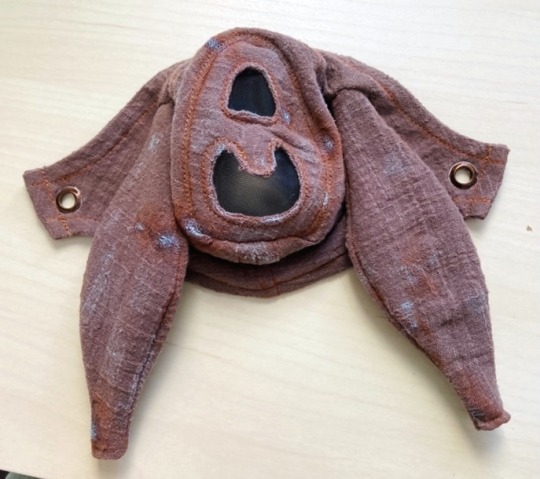
Shohki Mask Cover
construction notes & photos under the cut
This has been a long time coming! I'm glad she's a costume I can work a mask into without it breaking the design of the character. I feel like people would be less inclined to ask that you remove it for photos this way ^^;
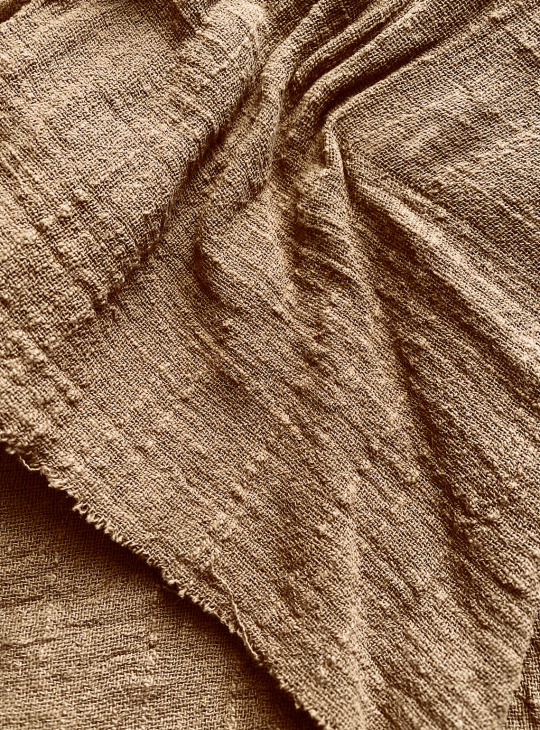
I went with a very thin cotton gauze fabric (#9 "coffee" if you're wondering), think a slightly thicker cheese cloth. It's very breathable as a single layer and seemed the best choice for an N95 cover. The shape was really only achievable with this fabric because of the shape of my mask underneath, and some strategically placed 1/2" wide horsehair braid tubing from the dollar tree. I usually stock up around halloween but they stock around christmas too!
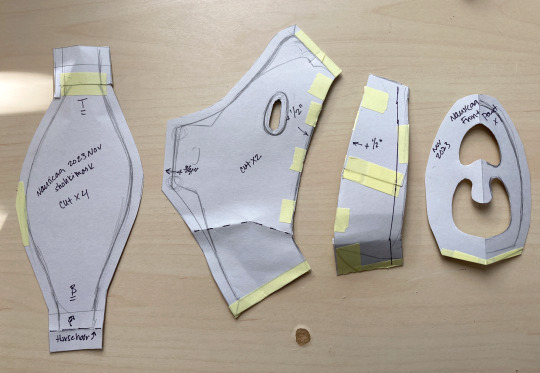
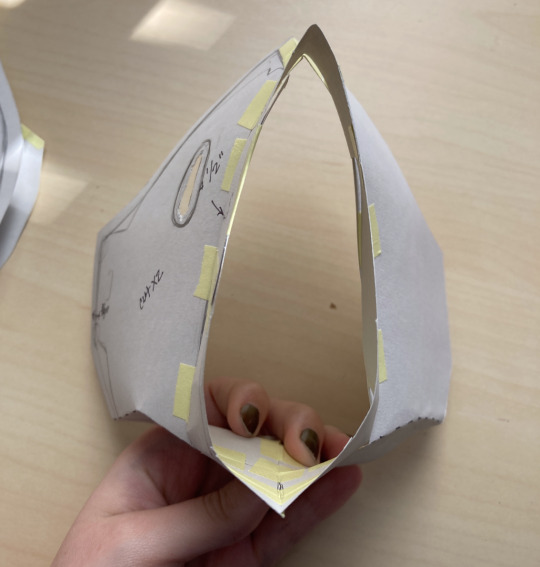
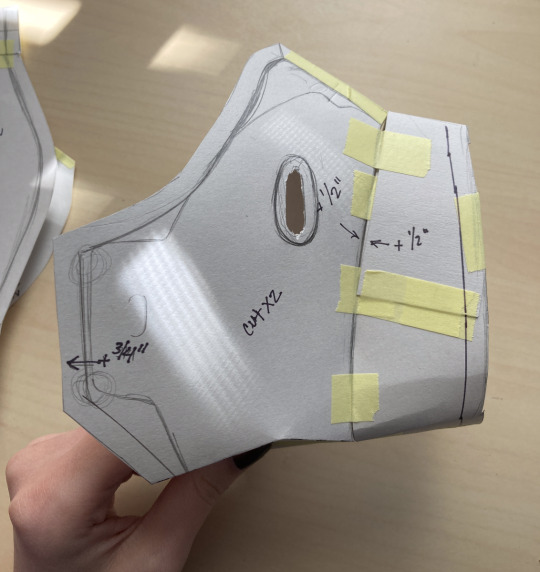
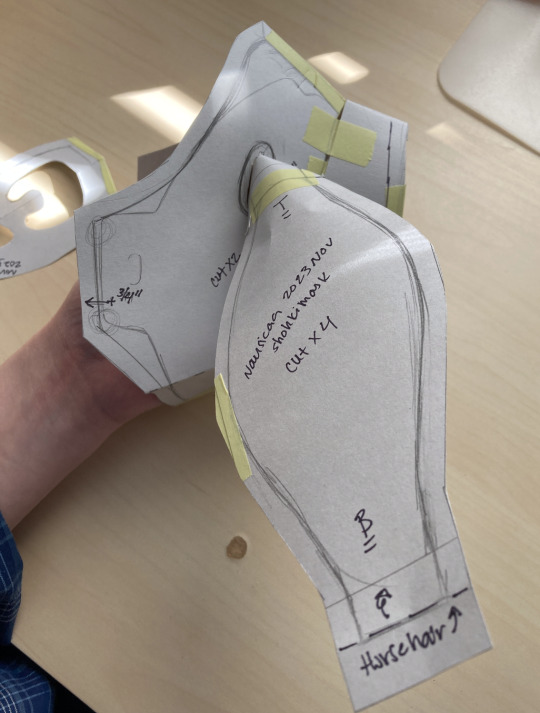
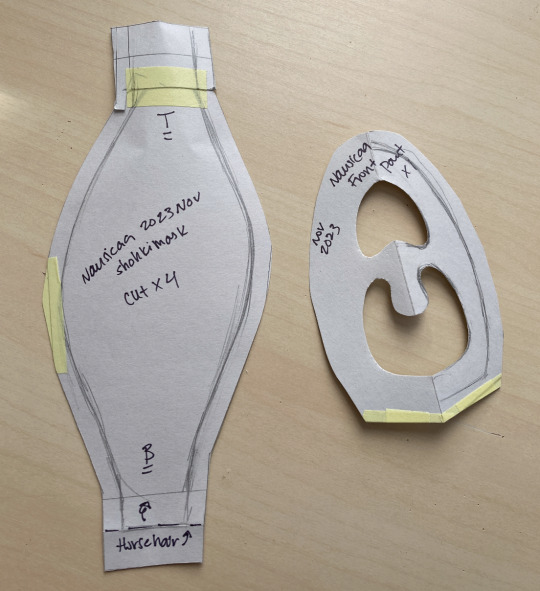
Process is very straight forward, just traced my mask on the fold and made some rough adjustments for a card stock mock up. I like 90-110 lbs for this sort of thing but construction paper can work in a pinch too. Cut that out and fit to my face, tweaked the placement on the nose bridge and added a 1/4" allowance for bias tape/facing, and appropriate allowance for flat felled seams.
The ear tab was extended to cover the mask underneath, and included allowance for support fabric (denim scrap in my case) to support two eyelets intended to thread the elastic of my mask through. Then it was just patterning out the rest of the mask elements and making note of seam allowance and how to cut each piece. I trimmed the tape holding together the card stock mask apart and finally got to cutting out the fabric once that was done.
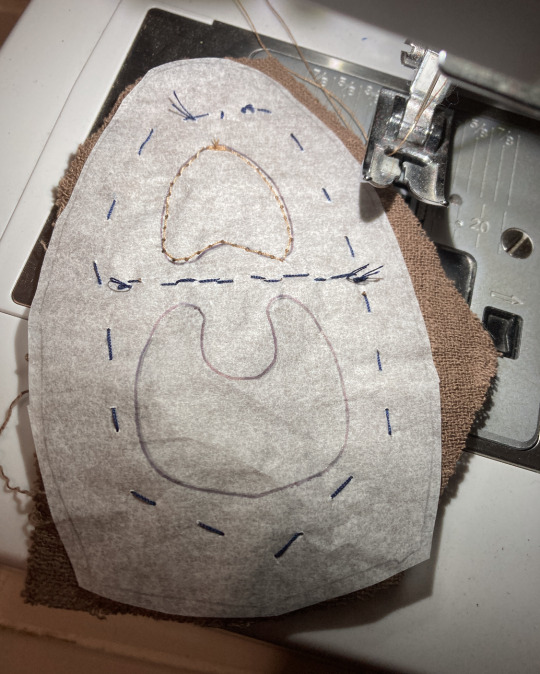
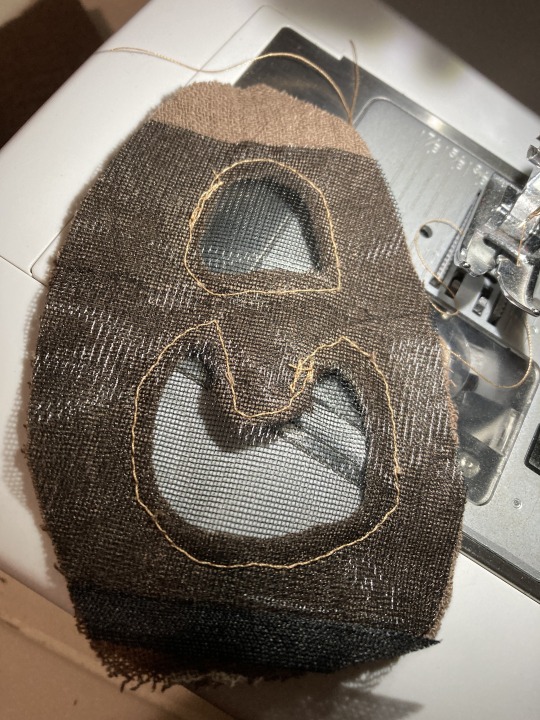
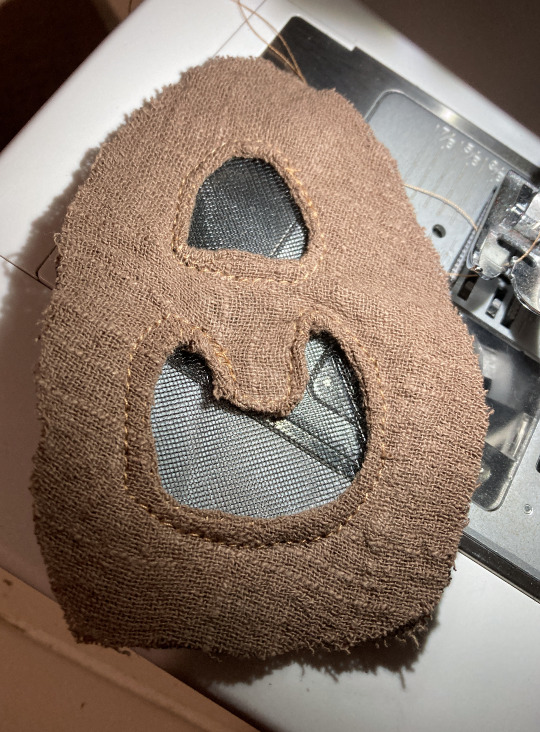
There isn't anything fancy going on, the hardest part was just the inset mesh panel over the weirdly shaped keyhole cut outs on the mouth piece. It's just black nylon mesh typically used for interfacing bras sewn on after making the keyholes.
This fabric is like if toilet paper were a textile, which is great for breatheability and weight but absolutely hell for machine work like this. It's not for a competition so for me, hiding messy stitching with weathering later was ok.
The portion of the mask running from the underside of each ear tab was finished with homemade bias tape. The same method was used for finishing the top portion that runs over the bridge of my nose. The ends were simply folded and sewn down at the ear tabs for a clean finish.
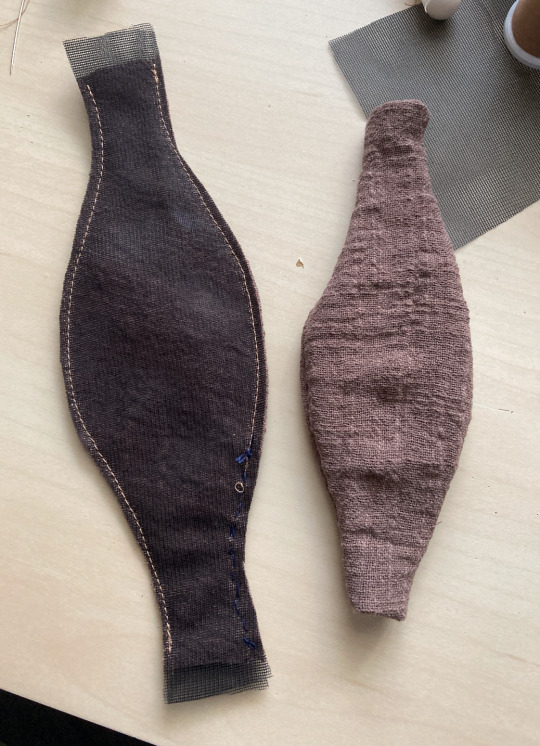
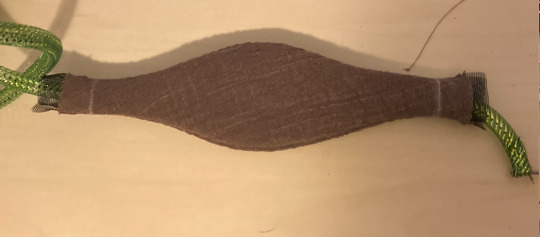
The side "filters" have an extra 1/2" long extension so I can tack in the ends of some horse hair tubing, then double fold the fabric back into itself before hand tacking with tiny stitches from the outside. That helps the light fabric balloon out into that shape, along with another layer of that same mesh interfacing.
They are really fun actually, very floppy with great movement. Though they stick out a tad too much so I did add one small french tack to the center of each to help them point downwards but retain that movement. The "filter" took the most hand finishing out of the whole thing, but that was to be expected.

Once the little side "filters" were sewn in, there was just light weathering to do. I wanted to add some shadows and potential "mold spores" to certain areas to really make the texture pop and hide some messy stitching. Light passes with a dry brush and some acrylic helped a lot, so did referencing photos of mold growth on clothes.
It was a pass of burnt sienna along all seams and large patches where high humidity would accumulate. Then another lighter pass of burnt umber to deepen up areas, and some very sparse areas of white. Finally I wanted to give it the "blue cheese special" and mixed a little viridian green and that same white and hit the white areas first then dry brushed the spaces between mold patches. I'm trying to replicate active mold colonies so reference photos came in handy here. I also used some nail polish to match the grommets to fabric.
Maybe when I am not crunched for time I will get around to digitizing the pattern, but for now I hope the photos help anyone else trying to plan out a mask. Obviously the shape will change a lot depending on the sort of fabric and mask you have on under it, not to mention face shape. I would imagine bifolds would give you more her classic feed bag profile than an origami style mask, however.
257 notes
·
View notes
Text
1. Essential Sewing Techniques
Basting: Temporary long stitches to hold fabric before final sewing.
Backstitch: Strong hand stitch for seams that need durability.
French Seam: Elegant finish that hides raw edges inside a folded seam (common in high-end garments).
Gathering: Creates controlled fullness (e.g., ruffles on sleeves or skirts).
Zigzag Stitch: Prevents fabric fraying on raw edges; used in stretch fabrics.
Quilting: Combines piecing (sewing fabric patches) and stitching through layers for texture.
2. Cultural & Historical Significance
Ancient Egypt: Linen garments were hand-sewn with flax thread; some stitches survive today.
Japan: Sashiko embroidery (functional decorative stitching) reinforced workwear.
Europe: The 18th-century mantua dress required intricate draping and sewing skills.
Industrial Revolution: Sewing machines (like Singer’s 1851 model) democratized fashion but also fueled sweatshop labor debates.
3. Must-Have Sewing Tools
Fabric Shears: Sharp scissors reserved only for fabric.
Seam Ripper: Fixes mistakes without damaging material.
Tailor’s Chalk/Marking Pens: For tracing patterns.
Thimble: Protects fingers when hand-sewing thick fabrics.
Bobbins: Hold thread in sewing machines.
Rotary Cutter & Mat: Precision cutting for quilters.
4. Modern Sewing Innovations
Computerized Machines: Auto-threading, embroidery designs via USB, and touchscreen controls.
3D Printing: Custom buttons, accessories, or even fabric-like materials.
Smart Fabrics: Sewable LED circuits, conductive thread for wearable tech.
Sustainable Stitches: Growing use of upcycled materials and zero-waste pattern design.
5. Famous Figures in Sewing
Coco Chanel: Started as a seamstress; revolutionized women’s fashion.
Elizabeth Keckley: Former enslaved woman who became Mary Todd Lincoln’s dressmaker.
Yves Saint Laurent: Master of precision tailoring.
Contemporary Makers: Blogs like Tilly and the Buttons and YouTube sewists inspire DIY fashion.
6. Sewing’s Psychological & Social Benefits
Mindfulness: Repetitive stitching can reduce stress (like "textile therapy").
Community: Quilting bees, online sewing forums, and #SewingTwitter foster connection.
Empowerment: Self-sufficiency in making/modifying clothes challenges fast fashion.
8 notes
·
View notes
Text
They take you in the night
Pressed against a shed, drilled into your soul,
The arts of poverty and politics.
You dawn your jumpsuit and speak not of it
Trailing down your leg,
The drudgery of man fills your shadow
Your step haggard your back hunched
As you take your seat at the machine.
She groans and twists to your touch
Her winding cables dug deep into your skull
Engaging the turbulence day in and day out, absent reprieve
A despotic hum reverberating through the hail
The grinding of gears soot and smoke stacks
Pistoning through your mind
That cold crumble of the hydrolic press
Pushing into you, molding you into the spike of a wheel
Without mercy, it folds you
Not out of malice nor care
Silent indifference to what's crushed beneath it's weight
From your new shell, you look up at the stars
Such violence, they are ripping each other apart out there
But from where you stand
Pretty points of light hang from the sky,
They illuminate the factory floor for a brief moment
Before you're lost in the textile
2 notes
·
View notes
Text
𝔖𝔬𝔣𝔱 𝔖𝔠𝔲𝔩𝔭𝔱𝔲𝔯𝔢




Inspired by the fashion seminars and Athena Papadopoulos’ sculptures, I decided to make a soft sculpture as I haven’t done much textile work. I wanted to centre it around the idea of divine femininity because this is such a significant part of witchcraft. I thrifted some scarves to use as material and I think the colours and patterns are pretty cool. The material with text on it (I think it’s Latin) kind of reminded me of an incantation or reciting a spell which is relevant too.





I used the sewing machines to create the layers of the vulva and filled them with stuffing. Even the folds and creases in the untouched fabric resembled the labia to me. It was interesting to see what shapes it took naturally, and that was also helpful in assembling the layers in a natural sort of way.
6 notes
·
View notes
Text
DIY Ottoman Slipcover

Project by Brett Bara:
If you’ve got a boring old ottoman hanging around, or if, like me, if you happen to find one of those plain cubes on sale, it’s easy to recover with a custom slip cover. This is another fantastic way to bring some fun textiles into a room with a project that you can sew in an afternoon or less. (I swear!)
This slip cover uses only basic straight seams, and I’ll show you the trick for getting nice, sharp 3-D corners. So let’s get started! –Brett Bara
What You’ll Need


1-2 yards fabric, depending on the size of your ottoman
Sewing thread to match
Tape measure
Sharp scissors
Straight pins
Sewing machine
Iron and ironing board
Selecting and Preparing Fabric
A heavier-weight fabric is great for this project since you’ll want it to be sturdy enough to stand up to some wear and tear. Heavy cotton, canvas or duck cloth are all great choices, as are many upholstery fabrics. If you have kids or pets or otherwise expect your ottoman to need to be laundered regularly, you might want to choose a machine-washable option. As always, I recommend beginners start with smooth-textured fabrics, so avoid any options with a lot of texture until you’re comfortable with sewing.
I’m using Butterfly Jubilee from Mod Green Pod, which is a heavy cotton.
If your fabric is machine-washable, wash, dry and iron it before beginning.
Measuring and Cutting

Measure the ottoman from edge to edge, and note the size of the top and sides.
To the top piece: add ¾” to the height and width. So if the ottoman top measures 14” square, you need to cut 1 piece of fabric that’s 14 ¾” square.
To each side piece: add ¾” to the width and 1 ½” to the length. So if each side of the ottoman measures 14” square, you need to cut 4 pieces of fabric that are 14 ¾” by 15 ½”. (As you proceed, be sure to sew the side pieces so that the longer sides are vertical; the extra length is for the hem.)
*Note: these instructions call for a ½” seam allowance, yet I’ve instructed you to cut each piece ¾” larger than actual size (normally you’d cut each piece 1” larger than actual size, to allow for the ½” seam allowance on both edges). But because you want the slip cover to be snug, we’re decreasing the normal 1” extra to ¾”, for just a smidge of negative ease.
Time to Start Sewing
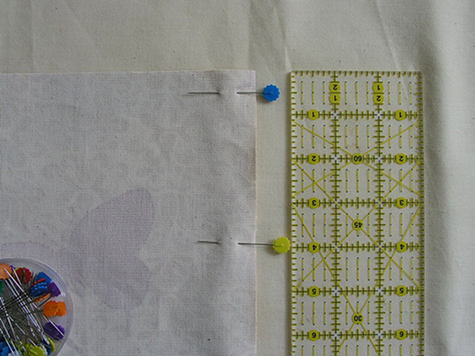
Place two side panel pieces right sides together, with longer edges aligned. (You will be sewing along the longer edges.) Remember to check to be sure your fabric pattern print is facing in the right direction so that your print won’t be upside-down!
The trick of this project is that you want nice, neat corners on your slip cover. To accomplish this, leave ½” unsewn at the top of the seam. Measure ½” from the top edge of the fabric and place a pin to mark the spot. Continue to pin the two pieces together along the entire edge you will be sewing.

Begin sewing at the first pin with a ½” seam allowance. (Again, leaving that first ½” open). Backstitch to reinforce at the beginning and end of this and all seams for this project, and continue sewing all the way to the edge of the fabric.

This is what it will look like with the open ½” at the top of the seam.

Sew all four side pieces together in this manner, forming a tube. Iron all seams open and flat.

Slip the tube over the ottoman to make sure it fits well. If it’s not snug enough, make note of how much smaller it needs to be, and redo the seams where necessary. It it’s too snug, you can let out seams.
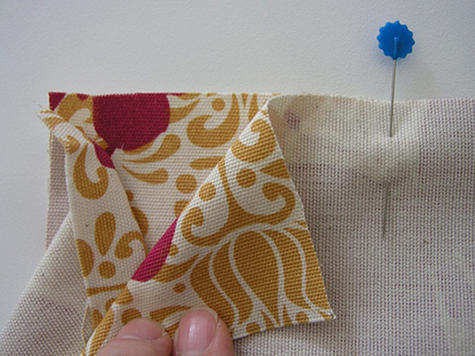
Now it’s time to add the top piece. Align one edge of the top with the edge of one of the sides. To get nice, neat corners, here’s the trick: Fold down the ½” open flap at the top of the side seam, completely out of the way. Then place the top piece of fabric over this.

Feel with your finger where that folded-over flap ends, and place a pin at an angle right at the spot where you feel the fabric ending underneath. Your goal will be to begin the next seam right at that spot. This spot is ½” from the top edge of the fabric, with a ½” seam allowance.
Continue to pin along the seam, and repeat the same process at the other corner, folding down the fabric underneath and placing a pin at that spot.
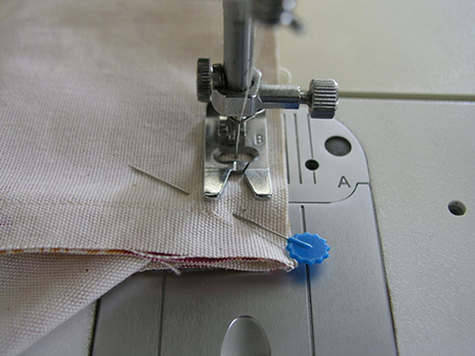
Sew along this edge, from corner to corner, with a ½” seam allowance – beginning and ending the seam ½” from the edge of the fabric (so you’re leaving ½” open on both ends). Remember to back stitch to reinforce the beginning and end of these seams.
Repeat around all four edges of the top, pinning and sewing each side separately as you go.

You’re almost done! Turn the slip cover right-side out and try it on again for size. Take this opportunity to double-check the hem; you should have 1” of excess fabric along the bottom for the hem, but if any shifting occurred, you may have more or less. Take note of that now and adjust accordingly when turning up the hem.

Turn the piece inside-out again and clip the corners on all three sides where they intersect. Removing this excess fabric reduces bulk inside the corners, for sharper edges.

To hem the bottom, turn under the fabric ½” along all 4 sides of the bottom, pressing as you go. Turn under another ½”, press, and pin in place.

Sew the hem, close to the interior folded edge. Finally, press open all seams on the finished piece.

You’re done! Don’t you love your new ottoman??
8 notes
·
View notes
Text
I remember learning how women spun all the time¹. I remember learning it was a vital necessity, not a display of purely artistic skill for elite women like Victorian ladies with harpsichords and watercolours. I remember learning how late spinning wheels came in (first in India then spreading west), and how they increased thread production fifty-fold, and professionalised much of spinning.
¹: at an embarrassingly old age; at least a decade after I'd actually spun some shitty thread at camp
Now sure I'm kind of a dumbass, but I've also been done dirty by The System. School taught me about developments in agriculture, including the difference between an ard and a plough, but mentioned textile production… maybe once in passing?
Books (fiction and non-) showed spinning and sewing and embroidery as this stupid frivolity that noblewomen kill time with because they're not allowed to do anything important like combat and horsemanship. Peasant women are vaguely working fields somewhere (but less effectively than their husbands and fathers, because ploughing requires more upper body strength), or tending children; definitely something subordinate to men's work. It's probably bad to grow up with a completely wrong idea of the economic importance of a whole gender.
It's beautiful that you're keeping it alive, mastering at the skills, teaching others about it.
But… I see it as liberation.
Women freed from the distaff, even in the poorest countries. People able to go anywhere with idle hands, or reading, or looking at their phones, or doing anything they damn well please.² Clothes so cheap that I change them every day (oh yeah, washing went from one of the hardest tasks to just pushing a button, too). Fabric so abundant that it makes more sense to make it shitty and fragile, because it's not worth mending anyway when you can replace it so easily.
²: But unlike spinning and weaving, sewing is still mostly done by individual seamstresses in sweatshops rather than automated, and the working conditions are pretty fucked up. Sewing machines make the work much more productive but not much more pleasant for individual workers.
Likewise, I would love it if cooking was a totally optional hobby; if your family would be fed without anyone being chained to the stove³, or even needing to know what cooking is; if "go back to the kitchen and make me a sandwich" was incomprehensible. I'd mourn the loss of artistry, but I wish my dad hadn't had to do works of art every day to keep me alive, y'know?
³: If you're an historian reading this post in the far future: "chained to the stove" is a metaphor for the constraint it imposes on your schedule; literally chaining someone to a stove would be horrifying unless it was, like, a kink thing.
Man, living in the future sure is weird.
Vaguely related: I've wondered how my clothes are made (not clothes generally in history, my clothes), and it's oddly hard to find information — sources talk far more about history than about the present. I can find a little on spinning, but almost nothing on weaving. Some of it is probably industry secrets, but come on, it shouldn't be too hard to answer questions like roughly how many looms are in industrial operation, what's the most common type, and where in the world they mostly are.
I've had a hard time articulating to people just how fundamental spinning used to be in people's lives, and how eerie it is that it's vanished so entirely. It occurred to me today that it's a bit like if in the future all food was made by machine, and people forgot what farming and cooking were. Not just that they forgot how to do it; they had never heard of it.
When they use phrases like "spinning yarns" for telling stories or "heckling a performer" without understanding where they come from, I imagine a scene in the future where someone uses the phrase "stir the pot" to mean "cause a disagreement" and I say, did you know a pot used to be a container for heating food, and stirring was a way of combining different components of food together? "Wow, you're full of weird facts! How do you even know that?"
When I say I spin and people say "What, like you do exercise bikes? Is that a kind of dancing? What's drafting? What's a hackle?" it's like if I started talking about my cooking hobby and my friend asked "What's salt? Also, what's cooking?" Well, you see, there are a lot of stages to food preparation, starting with planting crops, and cooking is one of the later stages. Salt is a chemical used in cooking which mostly alters the flavor of the food but can also be used for other things, like drawing out moisture...
"Wow, that sounds so complicated. You must have done a lot of research. You're so good at cooking!" I'm really not. In the past, children started learning about cooking as early as age five ("Isn't that child labor?"), and many people cooked every day their whole lives ("Man, people worked so hard back then."). And that's just an average person, not to mention people called "chefs" who did it professionally. I go to the historic preservation center to use their stove once or twice a week, and I started learning a couple years ago. So what I know is less sophisticated than what some children could do back in the day.
"Can you make me a snickers bar?" No, that would be pretty hard. I just make sandwiches mostly. Sometimes I do scrambled eggs. "Oh, I would've thought a snickers bar would be way more basic than eggs. They seem so simple!"
Haven't you ever wondered where food comes from? I ask them. When you were a kid, did you ever pick apart the different colored bits in your food and wonder what it was made of? "No, I never really thought about it." Did you know rice balls are called that because they're made from part of a plant called rice? "Oh haha, that's so weird. I thought 'rice' was just an adjective for anything that was soft and white."
People always ask me why I took up spinning. Isn't it weird that there are things we take so much for granted that we don't even notice when they're gone? Isn't it strange that something which has been part of humanity all across the planet since the Neanderthals is being forgotten in our generation? Isn't it funny that when knowledge dies, it leaves behind a ghost, just like a person? Don't you want to commune with it?
39K notes
·
View notes
Text
Top 6 Laundry Stores In Bangalore?
Washmart Yelahanka
Washmart HSR Layout
Washmart Rajarajeshwari Nagar
Limra Dry Cleaners
Laundroswitch
Give Laundry
Bangalore is a city known for its bustling lifestyle, where a major chunk of the working population, in keeping up with the city’s pace, finds it a challenge to maintain the balance between their professional demands and personal chores. Especially long working hours, busy schedules, and energy and time limitations leave little time for focusing on personal tasks and requirements. One such task that individuals tackle is maintaining clean, well-kept clothing despite their busy schedules, long work hours, and limited energy and time.
Thanks to the availability of world-class laundry services in Bangalore, anyone can now access a convenient way to get clothes cleaned without having to own a washing machine or dryer at home, especially those living in apartments with space limitations for personal laundry appliances.
Typically, consumers struggle to find specialized cleaning solutions for their delicate items and large batches of clothes that they find difficult to handle at home. Preserving the fabric quality of apparel and in-depth cleaning are also major areas of concern. That makes for a reason enough to resort to the services of the best laundry stores in Bangalore, offering same-day services and excellent clothes washing services.
Before Listing Down The Top Laundry Stores In Bangalore, Let’s Discuss Why Laundry Services Are Crucial:
Readily available: Laundry services are always accessible to anyone who needs to get their daily home wear, office clothes, woolen clothes, or home furnishings cleaned, with hassle-free pick up and delivery.
Time-efficient: By ensuring end-to-end management of laundry and dry cleaning services and offering a comprehensive range of services tailored to every individual’s garment needs, laundry services free up ample time for people to turn focus on other pursuits.
Professional services: The best stores in Bangalore provide access to high-quality laundry services, including everything from textiles and apparel to soft goods. Whether it is about ensuring care of delicate fabrics and premium clothes or providing solutions against tough stains, top-rate laundry services help with everything.
Cost-saving: For some consumers, utilizing laundry services can be much more beneficial and hassle-free than investing in expensive personal laundry appliances and using them depending on their lifestyle needs. After all, it’s so easy to drop off the laundry at your nearby store (or get it picked up at your doorstep) and pick it up at your convenience (or have it delivered to your doorstep).
Here Are The Top 6 Laundry Services In the city that are quite popular for their full portfolio of laundry services:
Washmart Yelahanka: Washmart, India’s leading dry cleaning, laundry & shoe cleaning chain, has its presence across the country, including in Yelahanka, Bangalore. The Washmart Yelahanka store provides a full range of high-quality laundry and dry cleaning services. This store in Bangalore offers a full spectrum of services from laundry, dry cleaning, shoe cleaning, and leather cleaning to carpet cleaning and curtain cleaning. Known for its world-class standard machines and top-notch cleaning solutions, Washmart is redefining the concept of laundry stores with its Yelahanka outlet.
Washmart HSR Layout: Washmart’s HSR Layout is known for its comprehensive range of laundry services in Bangalore, including washing, drying, and folding of clothes to ensure they are clean, fresh, and neatly organized. The store covers all the diverse needs of customers, whether related to home furnishings, haute couture, soft goods, textiles, and much more. The store also provides same-day services and doorstep deliveries.
Washmart Rajarajeshwari Nagar: located in the western suburb of Bangalore, Rajarajeshwari Nagar (R.R. Nagar) is a well-developed locality that offers a balanced mix of connectivity, amenities, and a tranquil environment. Washmart’s presence in this unparalleled location means only one thing—a strong focus on providing premium laundry and dry cleaning services at the best rates. The store’s focus on top-notch cleaning with budget-friendly rates ensures that customers always receive convenient, prompt, reliable, and personalized services.
Limra Dry Cleaners: Limra Dry Cleaners is a Bangalore-based laundry service provider. Limra offers a full range of services, including dry cleaning and laundry for various types of clothing and home furnishing goods. The store offers first-rate services, delivered on time.
Laundroswitch: Laundroswitch is a retail laundry service provider in Bangalore that covers the gamut of dry cleaning and laundry services, including steam ironing, stain removal, starching, premium laundry, and dry cleaning. The store takes utmost care in delivering the best services at reasonable rates.
Give Laundry: Give Laundry is another reputable service provider that places a premium on customers’ convenience and quality care for all types of clothing.
The service providers listed above offer comprehensive laundry and dry cleaning solutions, tailored to each customer’s needs. If you want to offload your laundry hassles from your shoulders to a dependable solution provider, consider any of these excellent options to solve your laundry and dry cleaning woes.
0 notes
Text
Three Station Automatic Sheet Rewinding Frame Machine
The structure of the blister folding machine is three-sided pressure blister molding. Generally suitable for the blister packaging industry, it is widely used in electronic products, stationery, food, lighting, decoration, electrical appliances, daily necessities, medical, pharmaceutical, textile, handicrafts and other industries.

Contact us Phone: +86 18621972598 E-mail: [email protected]
0 notes
Text
The Thread That Found Them All
The first time she saw it, it was folded neatly on a low wooden counter, surrounded by tea glasses and idle afternoon chatter. A bottle green bandhani dupatta, rich and deep like forests at dusk. The shopkeeper didn’t push it toward her. It simply sat there, waiting to be noticed.
She was in the middle of planning a wedding she had no desire to turn into a spectacle. There would be no five-day affair, no band, no sparkle-heavy lehenga. Just her, the person she loved, and their families under the same roof, with laughter and food and the smell of raat ki rani floating through the open courtyard. But she still wanted to wear something that felt like a moment.
When she lifted the dupatta and let it fall across her forearm, it had a certain gravity. Not heavy in weight, but in presence. The fabric was soft, yet dense. The white tie-dyed dots—deliberate, infinite—ran across the green like constellations, while the edges were kissed with just enough gold to catch the light. She didn’t imagine herself twirling in it. She imagined stillness. A quiet confidence. A knowing.
It would be her only indulgence. She paired it with an old cream kurta stitched by her mother. On the day of the wedding, the dupatta carried her—through laughter, through silent glances, through moments that would etch themselves forever in the corners of her memory. She didn’t save it in a box afterward. She kept it near. Some things aren’t for preservation. They’re for returning to.
In Kolkata, on the morning of a spring festival, an artist sat cross-legged in her small apartment surrounded by canvases, chai cups, and half-finished rangoli patterns. She was preparing to unveil a new collection inspired by monsoon nights and river songs. Every painting spoke in color—blues, oranges, muddy greys—but something about her felt incomplete.
She had always chosen clothes the way she chose brushes—with intention, with curiosity. That day, she reached for something she'd picked up from a forgotten textile fair months ago: a bottle green bandhani dupatta. She’d chosen it for its wildness. The uneven dots. The slightly frayed edge. The way the dye held onto some threads more tightly than others.
She wore it over a loose cotton sari, letting it fall like a careless thought over her shoulder. As people walked through the gallery that evening, they stopped to look at her, then at the paintings, then back again. It wasn’t vanity. It was harmony. She had, unknowingly, dressed like her art—layered, unapologetic, and rooted.
After the show, a child came up to her and asked if she was a magician. She smiled. Maybe she was. Maybe the dupatta had something to do with it.
In an office tower in Pune, a marketing manager stood by the coffee machine, stirring her fifth cup of the day. Deadlines blurred together, and meetings stretched like elastic. She often wore the same combinations—navy kurtas, black cigarette pants, a tired tote bag slung on her shoulder.
But today, she felt like reaching for something different. Not louder. Just more her. That morning, she pulled out the bottle green bandhani dupatta her aunt had given her years ago, folded neatly in the corner of her cupboard. It hadn’t been worn, only admired in passing.
She paired it with her usual clothes, nothing extravagant. But when she wrapped it around her, the day felt different. Less grey. Colleagues noticed. “New look?” someone asked. She shrugged. It wasn’t new. It was just… noticed now.
Later that day, during a pitch presentation, she caught her own reflection on a glass wall. The dots on the dupatta reminded her of design maps and data trails. Strange, how fabric could echo the language of code. Or maybe, how it reminded her that she could belong in both.
The traveler found it by accident. She had taken a spontaneous trip to Bhuj, drawn by stories of salt deserts and silent skies. She wasn’t looking for anything—only air and time.
The town was quiet that day. A narrow lane led her into a small shop where fabrics spilled out like watercolors. She ran her hand across silks and cottons, and paused when her fingers met something textured. The green was like jungle shadows after rain. The tie-dye patterns weren’t perfect, which made them feel more human.
She didn’t think twice. She bought it, stuffed it in her backpack, and didn’t look at it again until three days later when she was in a village near the edge of the Rann. The nights had grown colder. She wrapped the dupatta around herself while sitting by a fire, the fabric taking on the scent of woodsmoke and chill air.
It wasn’t glamorous. It wasn’t even a planned purchase. But it became her blanket on trains, her shield in crowded buses, her quiet companion in photos she wouldn’t post online.
Back in the city, every time she pulled it out—creased, slightly worn—she remembered the feeling of being small under stars and large in spirit. That was the power of it.
In Mumbai, a man once known for his face on cinema posters leaned out of his balcony, watching the city light itself up before Diwali. He no longer did interviews. The camera didn’t follow him anymore, and he liked it that way. He spent his days writing now—short scripts, voiceovers, sometimes just pages that no one would ever read.
He had begun to appreciate silence and stillness. In the drawer where he used to keep cufflinks, he now kept fabrics he’d collected from across the country. Among them was a bottle green bandhani dupatta—gifted to him by a script assistant on a set many years ago.
That night, he wore it around his neck like a scarf, over a white kurta and soft pajamas. He wasn’t going out. He just wanted to feel something ceremonial, even in solitude.
As the fireworks cracked in the distance and the breeze caught the edge of the fabric, he remembered a line from a play he once performed: “Some things are loud without speaking. Some things speak without sound.”
He smiled. This was one of them.
The bottle green bandhani dupatta found its way into many lives. It didn’t promise transformation, but it often delivered connection—between moments and memories, between people and the poetry they forgot lived inside them.
0 notes
Text
Ah, Margaret Knight!
A true visionary and a pioneer for women inventors.
Here's a glimpse into her remarkable life and achievements:
Early Life: Born in York, Maine in 1838, Margaret displayed a knack for invention from a young age.
As a child, she designed toys for her brothers and even created a safety device for textile looms at age 12!
The Paper Bag Revolution:
In 1868, while working at the Columbia Paper Bag Company, she observed the inefficiency of making flat-bottomed bags by hand.
Determined to find a better way, she invented a machine that could automatically cut, fold, and glue paper bags, revolutionizing the industry.
Battling for Recognition:
A man named Charles Annan attempted to steal her invention, claiming that a woman couldn't possibly design such a complex machine.
Margaret fought back, proving in court that the invention was hers.
She received her patent in 1871.
A Prolific Inventor:
Margaret didn't stop with the paper bag machine.
She went on to invent numerous other devices, including a rotary engine, a shoe-cutting machine, and a dress and skirt shield.
She held over 20 patents in her lifetime.
Legacy:
Margaret Knight is considered one of the most important female inventors of the 19th century.
Her story is an inspiration to anyone who has ever had an idea and dared to pursue it.
( #York, #Maine.) #paper #bag #recycle
0 notes
Text
Why Pluchi’s Bed Cover with AC Blanket is the Ultimate Year-Round Comfort Essential
When it comes to creating a cozy, stylish, and functional bedroom, the right bedding can make all the difference. Pluchi, known for its premium lifestyle textiles, offers an innovative product that blends comfort and versatility — the Bed Cover with AC Blanket.
But what makes this hybrid bedding piece a must-have in your home? Let’s explore.
1. Dual Purpose, Zero Hassle
Pluchi’s Bed Cover with AC Blanket is thoughtfully designed to serve two functions in one elegant package. By day, it works as a stylish bed cover, instantly elevating your bedroom aesthetic. By night, it transforms into a soft, breathable AC blanket — ideal for Indian summers and air-conditioned comfort.
2. Perfect for All Seasons
Unlike heavy quilts or thin sheets that only serve you seasonally, this multipurpose marvel is light enough for summer yet cozy enough for slightly cooler months. The cotton-rich knitted fabric regulates temperature and keeps you feeling “just right” no matter the weather.
3. Modern Aesthetic Meets Functional Design
Pluchi’s designs are subtle, modern, and tasteful — perfect for contemporary Indian homes. Whether you love minimal tones or soft patterns, these bed covers add a refined touch to your decor while remaining practical.
4. Travel-Friendly & Machine Washable
Going on a weekend getaway or staying at a friend’s? Fold it, pack it, and carry it along — no need to pack both a bedspread and a blanket. And once you’re back, just toss it in the washing machine. It’s as easy to care for as it is to use.
5. Sustainable Luxury
Pluchi uses eco-friendly dyes and ethically sourced cotton. You’re not just investing in your comfort — you’re also making a conscious choice for the planet.
Final Thoughts
In a world where functionality often comes at the cost of aesthetics, Pluchi’s Bed Cover with AC Blanket strikes the perfect balance. It’s versatile, elegant, and built for comfort. Whether you’re upgrading your bedding or searching for the perfect gift, this all-in-one essential deserves a spot in your home.
Explore the collection now on Pluchi.com and give your bedroom the cozy makeover it deserves.
0 notes
Text
"Handspun Maslin Fabric – Where Tradition Meets Luxury"
Discover the pure charm and legacy of Handspun Maslin Fabric, a textile that has been cherished for centuries for its unmatched softness, breathability, and exquisite craftsmanship. Rooted deeply in Indian textile heritage, Maslin (also known as muslin) has always stood out as a fabric of the elite—lightweight, luxurious, and delicately woven. Today, handspun Maslin fabric is making a powerful comeback, bringing with it a sense of authenticity and sustainable elegance that modern fashion desperately needs.
What sets Handspun Maslin Fabric apart is the technique and soul that goes into its creation. Unlike machine-made fabrics, each strand of this fabric is meticulously spun by hand and then woven with care by skilled artisans, many of whom are preserving techniques passed down through generations. The result is a fabric that feels as good as it looks—airy, soft, and ideal for all seasons. Whether you’re designing garments, home decor, or accessories, Maslin offers versatility and grace in every fold.
1 note
·
View note
Text
The Growing Demand for PP Woven Bag Making Machine in Ahmedabad
In recent years, the demand for PP Woven Bag Making Machine in Ahmedabad has seen a significant rise. As industries continue to shift toward eco-friendly, reusable, and durable packaging solutions, PP woven bags have emerged as a preferred choice for sectors like agriculture, cement, food grains, fertilizer, and retail. To cater to this demand, many businesses are now investing in advanced machinery that offers efficiency, precision, and scalability.
Why the Surge in Demand?
The packaging industry is undergoing a transformation driven by sustainability and cost-effectiveness. PP woven bags are not only reusable and strong but also customizable in terms of size and branding. This has led to increased production needs — and with it, the need for high-quality PP Woven Bag Making Machines in Ahmedabad.
Ahmedabad, known as a major industrial hub of India, has emerged as a preferred location for sourcing these machines. With a thriving textile and plastic manufacturing base, the city offers easy access to raw materials, skilled labor, and world-class engineering.
Gabbar Industries — The Best PP Woven Bag Making Machine in Ahmedabad
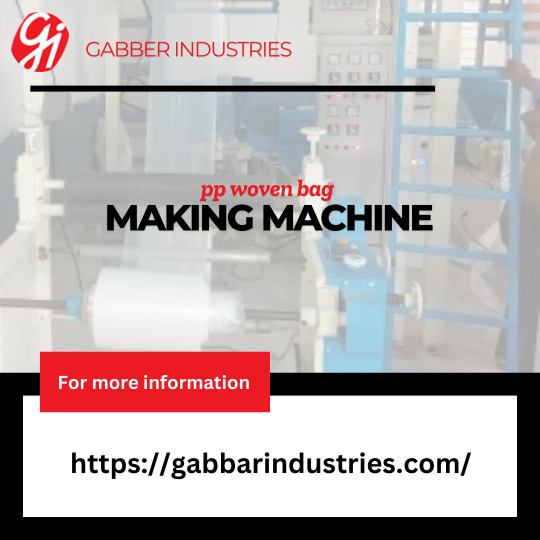
What Makes Gabbar Industries the Best?
Advanced Technology Gabbar Industries integrates the latest automation and control systems into its machines, ensuring high-speed production with minimal waste.
Robust Build Quality Built with durable materials, their machines offer long life and consistent performance, even under heavy-duty operations.
Customization Options Whether you need machines for small-scale production or industrial-level output, Gabbar Industries provides tailored solutions to meet your needs.
Energy Efficiency Their PP Woven Bag Making Machines are designed to consume less power, which reduces operating costs in the long run.
Excellent After-Sales Support From installation to training and maintenance, the team at Gabbar Industries ensures smooth operation and minimal downtime for your business.
Features of Gabbar Industries’ PP Woven Bag Making Machines
High-speed conversion of PP fabric into woven bags
Automatic cutting, folding, and stitching functions
PLC control system for ease of operation
Adjustable bag sizes and thickness
User-friendly interface and low maintenance
High output capacity with accuracy and precision
Why Choose a PP Woven Bag Making Machine in Ahmedabad?
Sourcing machinery from Ahmedabad brings multiple advantages:
Access to top manufacturers like Gabbar Industries
Competitive pricing due to local sourcing
Reliable logistics and faster delivery timelines
Better service and technical support
Rich pool of experienced engineers and technicians
Conclusion
The growing demand for PP Woven Bag Making Machine in Ahmedabad reflects the shifting landscape of the packaging industry. As businesses look for reliable, scalable, and sustainable packaging solutions, investing in a high-quality machine is critical.
If you’re planning to start or scale your PP woven bag production, there’s no better choice than Gabbar Industries — the best PP Woven Bag Making Machine manufacturer in Ahmedabad. Their commitment to quality, innovation, and customer satisfaction makes them a trusted partner for long-term success.
Are you ready to take your packaging business to the next level?
Contact Gabbar Industries today to learn more about their advanced PP Woven Bag Making Machines and get a solution that perfectly fits your production goals.
📞 Contact Gabbar Industries
Gabbar Industries — Trusted Manufacturer of PP Woven Bag Making Machines 📞 Phone: +919879039000 🌐 Website: https://gabbarindustries.com/
#pp woven bag making machine#pp woven bag making machine in ahmedabad#gabbar industries#woven sack bag conversion line manufacturer
0 notes
Text
Fabric Fun: Easy No-Sew Projects for Cozy Creativity

Fabric crafts are perfect for when you want to add a little softness to your DIY game. Whether it's leftover scraps from an old shirt or a mysterious bundle of fabric you found in your grandma’s sewing box, today’s projects will help you transform textiles into treasures.
And don’t worry—if the last time you touched fabric was while folding laundry (a dark time, I know), you’re still absolutely qualified to dive in here.
Why Fabric Crafts Are Worth It
Textiles add texture. (Say that five times fast.)
They’re comforting to work with. Like arts and crafts and therapy had a baby.
No sewing machine needed. Scissors, glue, and knots will get you far.
Scrap-friendly. Even the tiniest fabric bits can find a purpose.
Fabric Crafting Essentials
Let’s build your squishy toolkit:
Fabric scraps (cotton, denim, felt, jersey knit)
Fabric scissors (they do make a difference)
Hot glue gun or fabric glue
Safety pins or binder clips
Ribbons, buttons, beads, lace
Iron-on patches (optional)
Old T-shirts, pillowcases, or sheets (for upcycling)
Fabric glue dries quickly and holds strong—almost like it’s clinging to its dreams. Much like us, right?
Project 1: No-Sew Fabric Flowers
These little blooms are great for gift toppers, hair accessories, or that boring lampshade you’ve been meaning to upgrade since 2017.
Materials:
Fabric circles or strips
Hot glue or fabric glue
Button or bead (for center)
Steps:
Cut fabric into circles (around 3–4 inches wide).
Fold each in half, then in half again to make little fabric petals.
Glue petals in a circular arrangement.
Glue a button or bead in the center.
Boom. Blooms.
Pro tip: Use felt for a cleaner, more structured flower. Use silk or chiffon for a wispy, romantic look. Use dinosaur-print cotton for maximum chaos energy.
Project 2: Braided T-Shirt Bracelets
You know all those T-shirts with the weird underarm holes that you won’t wear but also can’t throw away? Let’s give them a second life—as fashionable arm candy.
You’ll Need:
T-shirt strips (approx. 1 inch wide, 12 inches long)
Tape or safety pin
Scissors
Steps:
Stretch the strips so they curl inward.
Tape or pin one end down, then braid three strips together.
Tie ends into a loop or knot.
Add a bead or charm if you’re feeling ✨extra✨.
These make great friendship bracelets, especially if you dramatically present them with a backstory like, “I made this from the shirt I wore to my first concert... in my living room... on YouTube.”
Project 3: Fabric Wall Hanging (Mini Patchwork Style)
Let’s make some wall art so cozy your walls will need a nap.
Supplies:
Small fabric squares (different colors/textures)
Sturdy base (felt sheet or cardboard)
Glue
Stick or dowel + string (for hanging)
Instructions:
Arrange fabric squares in a pattern or random mosaic.
Glue them to your backing base.
Glue a stick along the top, attach string, and hang.
The result? A boho-style textile masterpiece. Bonus points if you name it something dramatic like “Emotional Quilt #3.”
Crafting Mindset: Cut, Don’t Stress
Look, your fabric flower might not win a prize at a county fair. But did it make you smile? Did it distract you from doomscrolling? Did you accidentally glue your fingers together? All signs of a great craft session.
Beginners’ pep talk:
Fabric frays? Fringe it and call it “shabby chic.”
Glue blob? Add a button on top.
Pattern mix-up? It’s “eclectic.”
There are no mistakes here—just “creative pivots.”
Unique Fact of the Day:
The oldest known textile dates back over 34,000 years. Archaeologists found flax fibers in a cave in the Republic of Georgia—proof that fabric crafting is practically in our DNA. So if your fingers have a sudden urge to braid, wrap, or embellish, blame your ancient ancestors. They started it.
https://letterhanna.com/fabric-fun-easy-no-sew-projects-for-cozy-creativity/
0 notes
Text
Borana Weaves IPO: Price band set at ₹205–216 per share; check issue details, key dates, more
Borana Weaves IPO: Borana Weaves IPO will open for subscription on May 20 at a price band of ₹205 to ₹216 per share. The company plans to use IPO proceeds for a new manufacturing facility and working capital, with listing expected on May 27.

Borana Weaves IPO: Borana Weaves IPO price band has been fixed in the range of ₹205 to ₹216 per equity share of the face value of ₹10 for its upcoming public issue. Borana Weaves IPO date of subscription is from Tuesday, May 20 to Thursday, May 22. The allocation to anchor investors for Borana Weaves IPO is scheduled to take place on Monday, May 19.
The IPO floor price is 20.5 times the face value of the equity shares, and the cap price is 21.6 times the face value of the equity shares. The price-to-earnings ratio based on diluted EPS for fiscal 2024 at the lower end of the price band is 17.33 times, and at the upper end of the price band is 18.26 times.
Investors can apply for Borana Weaves IPO in a lot size of 69 equity shares, and in multiples thereafter.
Borana Weaves IPO has reserved not less than 75% of the shares in the public issue for qualified institutional buyers (QIB), not more than 15% for non-institutional investors (NII), and not more than 10% of the offer is reserved for retail investors.
Tentatively, Borana Weaves IPO basis of allotment of shares will be finalised on Friday, May 23, and the company will initiate refunds on Monday, May 26, while the shares will be credited to the demat account of allottees on the same day following the refund. Borana Weaves share price is likely to list on BSE and NSE on Tuesday, May 27.
About Borana Weaves
Borana Weaves Limited is a producer of unbleached synthetic grey fabric located in Surat, Gujarat. The company’s unbleached synthetic grey fabric is commonly utilised as a foundation for additional processing (including dyeing and printing) in sectors such as fashion, traditional textiles, technical textiles, home decor, and interior design.
Additionally, the firm produces polyester textured yarn (PTY Yarn), which is made by heating polyester oriented yarn (POY Yarn), the raw material used in creating grey fabric.
Borana Weaves Limited operates three manufacturing facilities in Surat, Gujarat, that are equipped with textile manufacturing technologies for various processes, including texturising, warping, operating water jet looms, and folding textiles.
As of September 30, 2024, the company had 15 operational texturising machines, 6 warping machines, 700 water jet looms, and 10 folding machines in its three facilities.
According to the red herring prospectus (RHP), there are no listed industry competitors in India or overseas, which could pose challenges in comparing and assessing their financial performance against other firms within the same sector.
Borana Weaves has shown impressive growth over the last three fiscal years. In FY 2024, the company disclosed revenue of ₹199.10 crore, representing a significant rise from ₹135.40 crore in FY 2023 and ₹42.30 crore in FY 2022.
Borana Weaves IPO details
Borana Weaves IPO, which is worth ₹144.89 crore, comprises of fresh issue of 67,08,000 equity shares. There’s no offer-for-sale (OFS) component.
Borana Weaves IPO objective is to use the net proceeds from the offering for several purposes, including financing the establishment of a new manufacturing facility to enhance its production capacity for grey fabric in Surat, Gujarat, India; providing additional working capital; and covering general corporate needs.
Beeline Capital Advisors Pvt Ltd serves as the book-running lead manager for Borana Weaves IPO, and Kfin Technologies Limited acts as the registrar for this offering.
“Investments in the securities market are subject to market risks.”
Intensify Research services is a SEBI registered Research analyst Indore committed to empowering investors with the most reliable stock market insights. Our team of expert analysts uses advanced tools and strategies to provide that enhance your chances of success. To visit- Intensifyresearch.com »
1 note
·
View note